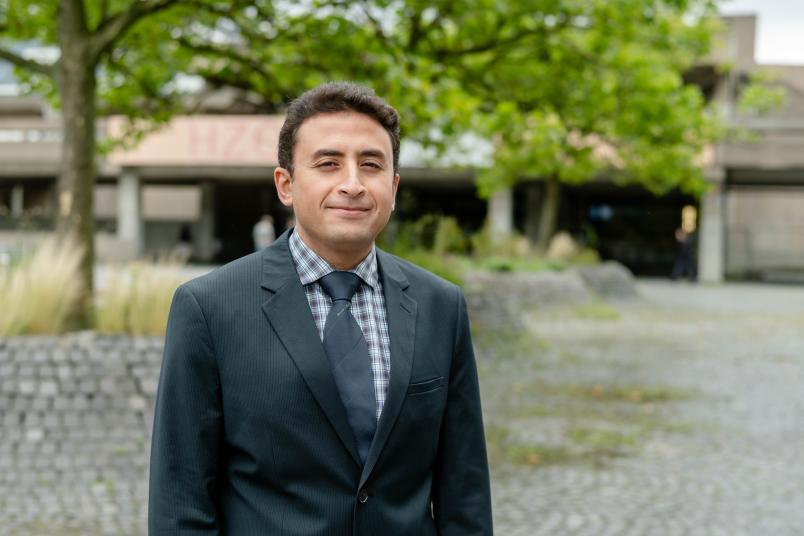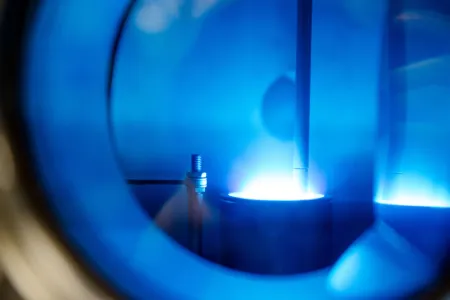
Interview
Humboldt Fellow Explores the Origin of the Solar Wind
Effects of Solar activity can reach Earth within minutes to few days. To predict potentially dangerous solar activity, and allow for protecting astronauts and spacecraft, scientists study the underlying plasma physics.
Dr. Mahmoud Saad Afify Ali Ibrahim investigates the microphysical mechanisms of heat flux regulation very close to the Sun. The plasma physicist is working together with the group of Professor Maria Elena Innocenti at the Institute for Theoretical Physics I at Ruhr University Bochum, Germany. In the interview he talks about work, his family and his ambitions for the future.
Mr. Ibrahim, could you please explain what you are surveying?
The Sun is a massive celestial body that primarily consists of plasma, the fourth state of matter composed of charged particles like ions and electrons. Interestingly, moving from the surface of the Sun to the corona, the outermost and hottest layer of the solar atmosphere, the plasma density decreases while its temperature, after slightly decreasing at the solar surface, increases going into the solar atmosphere.
The corona is the layer of the Sun’s atmosphere that emits the biggest part of the continuous stream of charged particles known as the solar wind. The latter is accelerated into the solar system at quite high speed: The fast solar wind easily reaches 800 kilometers per second.
Flares and Coronal Mass Ejections, transient, explosive events associated with changes in the magnetic field configuration and characterized by large increase in brightness and by the release of magnetized plasma from the Sun into interplanetary space, can move even faster.

It’s critical to understand as much as possible about the environment between the Sun and the Earth…to be in the position of mitigating the effects at Earth of disruptive solar events.
This solar wind activity can reach Earth, and solar energetic particles, which are accelerated to extremely high speed, are even capable of harming spacecraft equipment and putting people at risk, particularly those that are in deep space, where they are not protected by Earth’s magnetic field.
Our goal is to investigate the microphysical mechanisms of heat flux regulation in the inner atmosphere of the Sun using recent observations from the Parker Solar Probe mission, launched in 2018. We expect that our results will help to interpret recent observations of heat flux regulating instabilities in the atmosphere of the Sun.
Also, it’s critical to understand as much as possible about the environment between the Sun and the Earth, not only for purely scientific reasons, but also to be in the position of mitigating the effects at Earth of disruptive solar events.

As part of the group, I will acquire new competences, especially in computational physics and physics of the Sun’s atmosphere.
Why did you choose to come to Bochum?
Professor Maria Elena Innocenti’s group is already investigating the role of kinetic instabilities in heat flux regulation in the solar wind. As part of the group, I will acquire new competences, especially in computational physics and physics of the Sun’s atmosphere. This will be important for my future career since numerical simulations are an essential tool in physics.
Additionally, I will have access to the observational data from the Parker Solar Probe, Helios- and Solar Orbiter-Missions. These will provide direct applications to my theoretical studies, thereby increasing my international visibility and reputation in the field.
Moreover, the project will support me in attending conferences, which are an important chance to create a network of international colleagues. Therefore, this project is a great opportunity for me to further enhance my independent research profile and significantly boost my chances of being promoted to professor in Egypt, where I hope to launch my own research group in the near future.

A great environment where you can gain more knowledge every day
Have you already found out something interesting beyond your work during your time in Bochum?
I find getting an overview of different culture to be highly beneficial. Because you can better comprehend the advantages and limitations of your own culture by learning how people with quite various lives live, react, and eat.
Are you comfortable here?
Sure, I feel comfortable at Ruhr University Bochum, where several facilities are available.
What did surprise you?
A great environment where you can gain more knowledge every day and start exploring High Performance Computing and code optimization.

At the weekends, I have much to do for my wife and three kids
What do you like to do when you are not working?
At the weekends, I have much to do for my wife and three kids: Mohamad is nine, Ahmed seven, and Hamza five years old. I need to play with my kids and help them gain more knowledge where they have different syllabuses: German and Egyptian. And we visit different shops and parks.
Moreover, I help my wife, Dr. Walaa Shaalan, who has a PhD in biology, with the housework so she can make some progress in her research work. In this way, she will have more time to be in good contact with research groups at Ruhr University Bochum.
Did you have the possibility to travel?
I visited Berlin in June 2023, where I met the President of Germany during the annual meeting of the Alexander von Humboldt Foundation. Moreover, I lived for two months in Cologne without my family, during my intensive German course and visited some places there. Through such events, we gain more knowledge about German culture.
Is there anything you want to add?
I would like to thank the Alexander von Humboldt Foundation for financial support. And of course, I would like to take the opportunity to thank Professor Maria Elena Innocenti for her hospitality and support.
